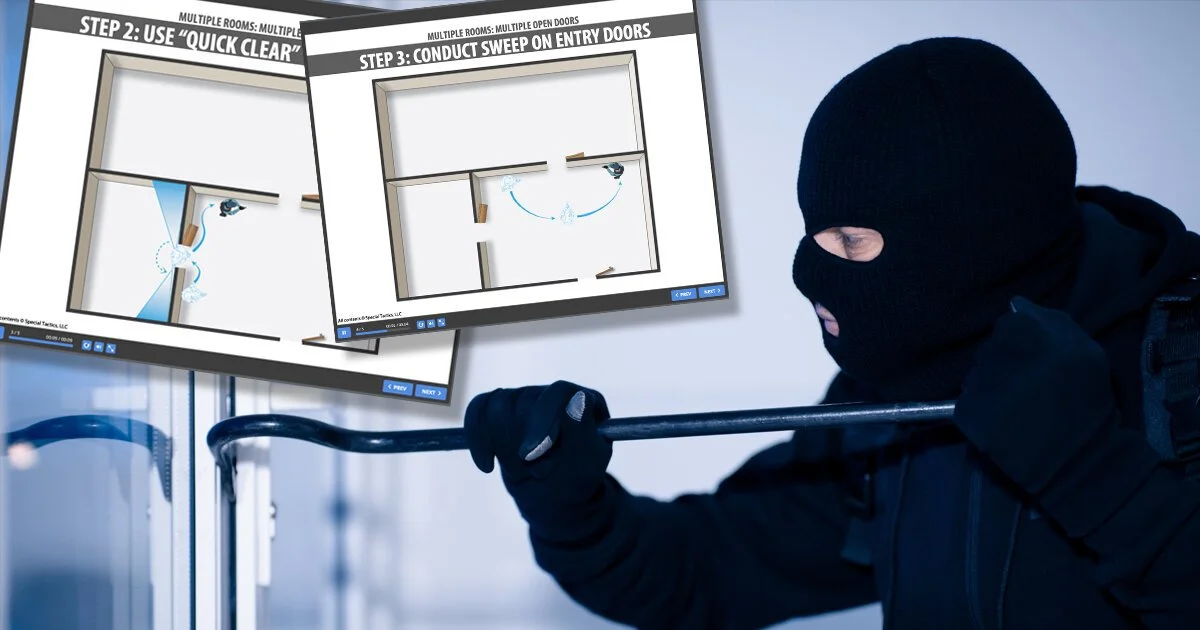Singleton CQB to Counter a Home Invasion
Since launching our new in-person training initiative we have received some requests to cover single-person (singleton) and two-person close quarters battle (CQB) techniques in a home invasion scenario. The article below is a partial extract from our Single-Person CQB Course which is now live on the Tactics Society online academy. We recommend our Single-Person and Two-Person CQB courses for any gun owners who want to better protect their homes. Click below to check out the course if you find the article useful.
In a home invasion situation, one or more criminals break into your house to steal your property or harm you and your family members. There are many measures you can take to prevent this from happening or to increase your odds of survival should it occur. However, while escape is generally the best option, for this course, assume that your preventative measures have failed, and escape is not possible. You have no other choice but to confront the intruders using the CQB techniques you learned in this course.
The first thing you must do in a home invasion situation is to call the police. As soon as the line connects, say the words home invasion and give your name and address even if they do not ask for it. If you are calling from a mobile phone, the police may not be able to locate you, and in the stress of the situation, you may not realize what phone you are using. Give your name and address immediately.
It is essential to tell the police that you are armed and prepared to defend yourself from the intruders. This will help prevent the police from accidentally shooting you if they see you holding a gun. If you have time, it might also help to tell the police what you are wearing so they can identify you more easily. From there, follow the instructions of the person on the phone. He or she will instruct you to stay on the line if possible. Therefore, it is good to have a headset ready, so you can keep both hands on your weapon and still communicate with the police. Give them as much information on the situation and the intruders as possible.
As you prepare to fight, understand that you have many advantages working in your favor. First, this is your home, and you know the layout better than the intruders. Ideally, you have practiced using CQB techniques to clear your house many times, and this will make your movements faster and smoother. Another advantage you have going for you is that you do not need to find and engage the intruders. If you hide in one place and avoid contact until police arrive, this is a satisfactory outcome. This means there is no need to expose yourself, cross hallways, stairs, or other dangerous areas. Since you are on the defensive, you can isolate the fight to one or two rooms, simplifying the problem for you but making it harder for the intruder.
Another advantage is that closed doors work in your favor. The intruder has to open closed doors or break through locked or barricaded doors. This makes noise and buys you time to call the police, set up your defensive position, or escape. Given this fact, if you have time, you might want to barricade doors to protect yourself. Have a barricade plan and practice moving the furniture to barricade doors beforehand to ensure the furniture is not too heavy to move in an emergency. You can also purchase regular rubber doorstops to jam a door and make it more difficult to force open.
If you are with your family, your priority is to keep them as protected as possible. Ideally, attempt to “back them into a corner” by putting them in a room or closet with only one entrance and exit. This allows you to guard that entrance and not worry about the intruders coming from different directions. Also, be sure to position your family away from any doors since doors tend to draw fire. Once your family is in the safest possible position, tell them to be quiet at all costs and choose your defensive position to guard them. Ideally, you should be close to your family but not right next to them. If the intruders shoot at you, even if you get shot, you do not want the bullets to strike your family as well. Also, if the intruders shoot you, they might panic and run away. If your family is not visible, the intruders may not go looking for them.
When choosing a defensive position, pick a place with good cover and concealment that allows you to surprise intruders from an unexpected angle as they turn a corner or walk into a room. It is useful to plan multiple fighting positions. Ideally, pick a good position, remain quiet, and move as little as possible. Wait for the intruder to walk into your sights. If you shoot one intruder, be prepared for more intruders to follow. If necessary, fall back to another fighting position and close doors behind you. This might discourage intruders from following you or give you time to find a better defensive position.
Finally, remember that loud noise can be an effective weapon in a home invasion scenario. In some cases, you might want to remain quiet and not give away your position. In other cases, you might want to make as much noise as possible by yelling, blowing whistles, or blasting an air horn. Loud noises have been known to intimidate intruders or make them nervous because all the commotion might lead to their arrest.
This is only a partial extract from the online course and companion manual. See below to find links both to the online course and manual. We welcome comments, suggestions and additional ideas on our Facebook page.

